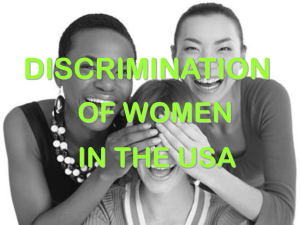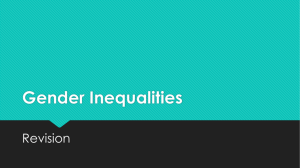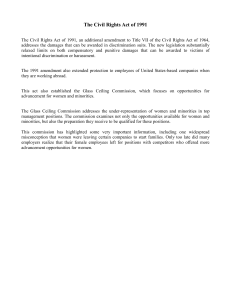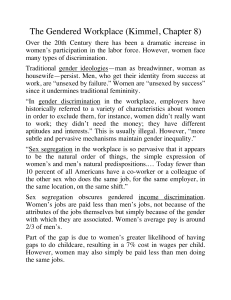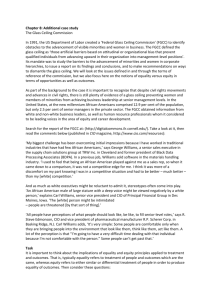Making Diversity Programs Successful in Contemporary Organizations Abstract
advertisement
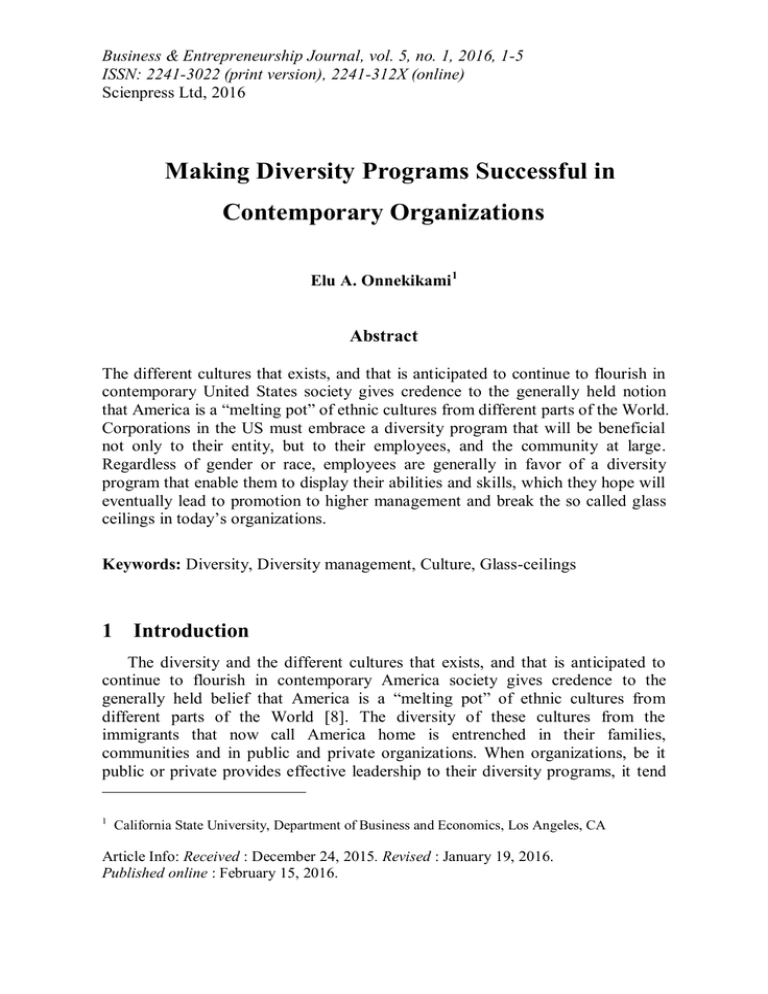
Business & Entrepreneurship Journal, vol. 5, no. 1, 2016, 1-5 ISSN: 2241-3022 (print version), 2241-312X (online) Scienpress Ltd, 2016 Making Diversity Programs Successful in Contemporary Organizations Elu A. Onnekikami1 Abstract The different cultures that exists, and that is anticipated to continue to flourish in contemporary United States society gives credence to the generally held notion that America is a “melting pot” of ethnic cultures from different parts of the World. Corporations in the US must embrace a diversity program that will be beneficial not only to their entity, but to their employees, and the community at large. Regardless of gender or race, employees are generally in favor of a diversity program that enable them to display their abilities and skills, which they hope will eventually lead to promotion to higher management and break the so called glass ceilings in today’s organizations. Keywords: Diversity, Diversity management, Culture, Glass-ceilings 1 Introduction The diversity and the different cultures that exists, and that is anticipated to continue to flourish in contemporary America society gives credence to the generally held belief that America is a “melting pot” of ethnic cultures from different parts of the World [8]. The diversity of these cultures from the immigrants that now call America home is entrenched in their families, communities and in public and private organizations. When organizations, be it public or private provides effective leadership to their diversity programs, it tend 1 California State University, Department of Business and Economics, Los Angeles, CA Article Info: Received : December 24, 2015. Revised : January 19, 2016. Published online : February 15, 2016. 2 Elu A. Onnekikami to benefit the organization and the society at large with cultural awareness and engagement. It also lower the levels of ethnocentrism, decrease in discrimination and stereotyping; and in most cases leads to a higher level of community service [3, 6]. In a perfect business or public Organization, the issue of diversity and cultural differences should not hinder any employee goal of becoming a top executive. Nonetheless, employees from different cultures and diversity continue to be a real issue(s) with the executive rank in many organization in the United States. Even though most Organizations in the US has seen a major advances in cultural awareness and diversity, the board rooms of most organizations continue to lack members of cultural diverse individuals whose hiring could indicate that the so called “glass ceiling” has once and for all been shattered [1, 8]. The main purpose of this article is to discuss diversity, diversity management and how to provide effective leadership in organization diversity programs. Research indicates as aforementioned, that organization diversity and culture continues to lack at the top level of leadership in most corporation or organizations in the US [1, 2, 8]. In order to ameliorate this organizations lack of cultural diversity, the author will discuss some obstacles that individuals from different cultures face, and will recommended strategies for managing diversity within organizations. However before delving further, some concepts related to diversity are hereby defined. 2 Definitions Diversity Diversity is a condition of being different; the inclusion of individuals from different cultures and ethnicities in a group or organization. Simply put, diversity means variety, and the benefits of having such a variety within an organization. Having diversity within a group or organization often leads to increased cultural awareness, less stereotyping, greater equity, decreased harassments and litigation, and an increased productivity and profitability. Additionally, diversity can help enhance communication skills and help build synergy in a company or organization. It can also help increase a company market share and create a huge satisfied customer base [7]. Effective organization diversity management process often help in the elimination of discrimination in a company. Discrimination is said to have taken place when an individual in organization allows their behavior to be influenced by stereotypes about a group of individuals. Rather than looking at individual Making Diversity Programs Successful in Contemporary Organizations 3 characteristics’, a perpetrator of discrimination assumes that everyone in a group are the same. This type of discrimination is often very damaging to an organization [2,6]. Culture Culture is the sum of customs, attitudes and beliefs that distinguishes a group of individuals from another. It is often transmitted through long held customs, ritual, institutions, languages and art [7,8]. Culture could also includes nationality, geographic area, educational level, gender, way of dressing, and social economic class to mention but a few, and are often learned from one generation to another [3,8]. An employee culture or ethnicity should never be a deciding factor as to who gets promoted into top level position in organizations and it should also not hinder the promotion of culturally diverse minorities [2,6]. Some scholars are of the opinion that minorities or employees from different cultures in some organizations have historically being marginalized and discriminated upon which have mitigated them from climbing the corporate ladder. This type of barrier is something referred to as the glass ceiling [8]. The Glass Ceiling The so called glass ceilings is a concept or metaphor utilized to describe the invincible or unseen barrier that tend to keep women and minorities from making it to the upper management or leadership position in an organization . The concept was originally coined by Hymowitz and Shcellhardt in the Wall Street Journal report of 1986 that described the obstacles faced by women who attempted to make it to higher management in Corporate America. The glass ceiling concept is not found in any business manual or discussed in corporate boards or in meetings. It is as, aforementioned, a covert, an unspoken phenomenon, that a school of thought believe is used by white males to keep women and minorites from making it to the top [6,8]. As the concept of glass ceilings became known and widespread, some women started dedicating their efforts in breaking down this invisible barrier that have mitigated them from climbing the corporate ladder. As women began to achieve some success in moving up to upper management positions in organizations, the concept began to take on a way larger meaning to include minorities, who in most cases has also faced challenges in climbing the corporate ladder. It is imperative that organizations educate management about the issues of diversity, culture and glass ceiling and how to effective manage diversity programs so that it will eventually shatter the glass ceiling once and for all [7,8]. Effective Diversity Programs in Organizations Organizations should utilize a variety of efforts to implement their diversity programs, including the selection and recruiting process, as well as development 4 Elu A. Onnekikami and training practices [7]. An effective comprehensive organization program that is successful often have three imperative and distinct components. First, the program must teach managers or those being trained about all anti-discrimination laws such as the title V1 of the Civil Right Act, Age discrimination Act, and the Equal pay Act to mention but a few, and how it relates to diversity. Additionally, every one in the organization should be encouraged to treat every one fairly regardless of their demographic characteristics or ethnicity. Secondly, management should be taught how a diverse work force in the organization will enable the company serve a diverse market of clients and customers. Thirdly, managers should be made to understand that a diversify workforce could help foster personal development, which in turn bring out the abilities and skills of all employees. Additionally, effective diversity program will enable employees to understand that acknowledging their differences in perspectives could provide a valuable way that could lead to improved performance [4,7,8]. Much of the issues or concerns about diversity in organizations have to do with unfairness. Most employees negative reactions to workplace discrimination are often based on the idea that they probably have been discriminated against based on the color of their skin or ethnicity, gender or sexual orientation [1,6,8]. Research has shown that, regardless of gender or race, employees are generally in favor of diversity program, if they believe that the organization policies ensure that everyone in the company have a fair opportunity to display their abilities and skills, that will eventually lead to promotions to higher management positions [2,3,5]. Study have also shown that organizations that provides diversity training program were more likely to have minorities and women in upper level management position than organizations that are not. The study also indicated that one-shot diversity training sessions without comprehensive strategies’ to encourage additional training are often not effective [4]. For a diversity program to be truly effective, it must include strategies to measure representation of minorities and women in the organization in managerial positions. Such program must also hold managers accountable to acertian that the organization has a balanced demographic diverse management within the company [4,8]. Study also suggested that a diversity program is more likely to be successful if (1) if the program discourages stereotypical attitudes, (2) if the program encourages trainees to consider new perspectives about others, in order words treat each other as they will like to be treated, (3) if the positive experience from such training is encouraged to be repeated often. Organizational diversity programs based on the aforementioned principles has shown to be more effective [2,7,8]. Making Diversity Programs Successful in Contemporary Organizations 5 Conclusion Leaders in organizations should examine their workforce to evaluate or determine whether targeted group of minorities and women have been underrepresented in higher level management. If the Human resources department determines that the aforementioned group are not fairly represented in top management, the organization must look deeply for any hidden obstacles to achieving equal representation. This can be achieved by making selection of employees more transparent, and by providing training and development for those employees who have not had adequate training for promotion into upper management. Equally imperative, the organization must precisely communicate its policies to all their employees so that each and every one of them understand how and why certain policies and practices are followed. Programs and communication should focus as much as feasible on job performance and qualifications and not on color or ethnicities. References [1] Bezrukova, K. A, Jehn, K, & Spell, C.S. (2012). Reviewing diversity training: Where we have been and where we should go. Academy of Management Learning & Education, 207-227. [2] Cortina, L.M. (2008). Unseen injustice: Incivility as modern discrimination in organizations. Academy of Management Review, 33(1), 55-75. [3] Distelhorst, D.J. (2006). A transcultural leader’s resource materials for building personal, team, and organizational intercultural competence. Spokane, WA; Gonzaga University. [4] Kalev, F., Dobbin, F., & Kelly, E. (2006). Best practices or best guesses? Accessing the efficacy of corporate affirmative action and diversity policies. American Sociological Review, 71(4), 589-617. [5] Kunze, F. & Boehm, S.A & Bruch, H. (2011). Age diversity, age discrimination climate and performance consequences-A Cross Organizational Study. Journal of Organizational Behavior, 264-290. [6] Raver, J.L & Nishii (2010). Once, twice, three times as harmful? Ethnic harassment, gender harassment, and generalized workplace harassment. Journal of Applied Psychology, p236-254. [7] Robbins, S.P. & Judge, T.A (2013). Organizational Behavior (16th ed.) Pearson: Saddle River New Jersey [8] Wilson. E. (2014). Diversity, culture, and glass ceilings. Journal of Culture Diversity, 21(3), p86-89.
